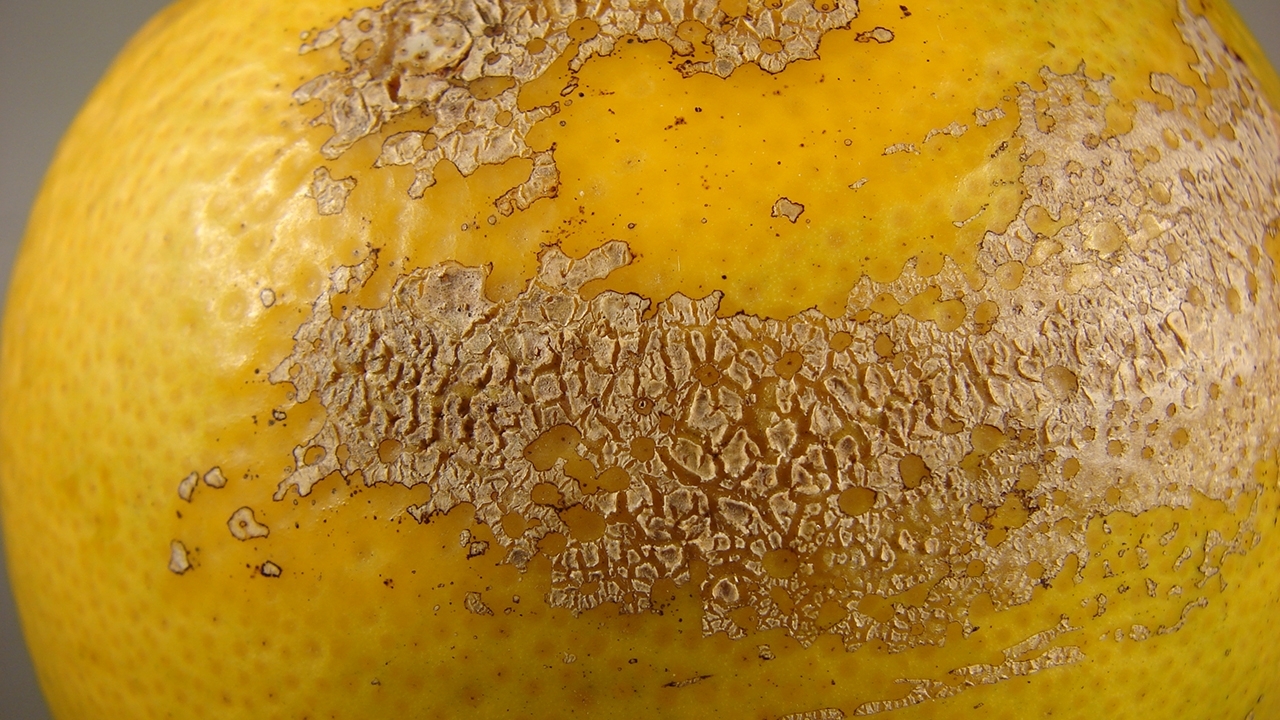Sweet Orange Scab

Sweet orange scab is caused by the fungus Elsinöe australis. Many citrus species and hybrids are vulnerable. Infection causes scab pustules that give fruit a corky appearance. Sweet orange scab can stunt young nursery trees or new field plantings and cause premature fruit to drop.
E. australis is spread by rain, irrigation, and the movement of infected plants. The fungal damage is superficial. It does not impact fruit quality and poses no danger to people, but the blemishes reduce marketability. In the United States, sweet orange scab was first detected in 2010 in residential citrus trees in Texas. It has since been confirmed in Alabama, Arizona, California, Florida, Louisiana, and Mississippi.
Sweet orange scab symptoms may be confused with other diseases, like citrus canker, or with environmental injuries. Symptoms may also vary by region due to differences in environmental conditions, like humidity.
Here are general symptoms to look for:
- Fruit and stems
- Scab-like lesions appear on young fruit. They are slightly raised and pink to light brown in color. (Lesions on orange and grapefruit are sometimes flatter.) As they expand, the lesions become cracked or warty and change to a yellowish-brown to dark gray color. Scabs are usually dispersed in the same pattern as water being splashed on fruit.
- Leaves
- Lesions begin on leaves as water-soaked spots which evolve into pustules. Typically, lesions are found on the underside of leaves near the mid-vein or border. Lesions on young tissue are usually raised, while lesions on mature tissue are usually flatter. Infected leaves can become irregularly shaped, stunted, or puckered.
View Images of Sweet Orange Scab
Note: Sweet orange scab can be easily confused with other diseases, including citrus canker. For a positive identification, reference our Field Guide for Sweet Orange Scab (936.9 KB).
- Don't move citrus trees. This is the fastest way sweet orange scab and other citrus diseases spread.
- Inspect your citrus trees regularly for infection.
There is no cure or treatment for sweet orange scab.
Report Signs of Citrus Disease
If you think you’ve seen signs of this disease or pest, immediately report your findings to a State Plant Health Director.
Controlling Sweet Orange Scab
Sweet orange scab is found in Alabama, Arizona, California, Florida, Louisiana, Mississippi, and Texas.
A potentially actionable suspect sample (PASS) is a regulatory sample1 from the environment or an APHIS-approved exclusionary facility2 where preliminary diagnostics indicate Elsinöe australis, a USDA-regulated pathogen, is present and requires confirmation by APHIS' Plant Pathogen Confirmatory Diagnostics Laboratory (PPCDL).
Samples Collected From a Nonregulated Area
Any regulatory sample collected from a nonregulated area3 or APHIS-approved exclusionary facility that tests positive using APHIS-approved tests for the presence of Elsinöe australis, the causative agent for sweet orange scab, is considered a PASS and must be forwarded to PPCDL for final determination. Sample4 should consist of symptomatic plant material (fruit or leaves).
Sample Diagnostics
USDA APHIS PPQ Science & Technology
Plant Pathogen Confirmatory Diagnostics Laboratory
9901 Powder Mill Rd., Bldg. 580
Laurel, MD 20708
Phone: 301- 313-9208 or -9271
When forwarding materials, notify the lab by email (APHIS-PPQCPHSTBeltsvilleSampleDiagnostics@usda.gov). Include the number of samples, screening diagnostic results, and tracking information in your email. Do not ship samples on Fridays or the day before a Federal holiday.
See more information for preparing and submitting samples
Samples Collected From a Regulated Area
A regulatory sample collected in a regulated area5 where preliminary diagnostics indicate the presence of Elsinöe australis is considered a PASS and requires confirmation by PPCDL only under the one or both of the following conditions:
- The sample is an unusual detection (novel symptoms or new host).
- The sample will result in the expansion of a previously established regulated area.
If neither of these conditions apply, the sample should be evaluated by the State-designated laboratory for final determination.
Definitions
1 Regulatory sample: This is a sample of regulatory concern to APHIS for sweet orange scab collected by regulatory officials.
(return to content)
2 APHIS-approved exclusionary facility: A greenhouse structure designed to exclude quarantine pests that is approved by APHIS to produce citrus nursey stock for interstate movement.
(return to content)
3 Nonregulated area: Any area where sweet orange scab is not known to occur in the United States.
(return to content)
4 Sample: A sample refers to a fruit or single bag of leaves (5–12 symptomatic leaves). It is strongly encouraged that each sample (fruit or leaf) is from a single plant.
(return to content)
5 Regulated area: Any APHIS-recognized area where sweet orange scab has been federally confirmed.
(return to content)

